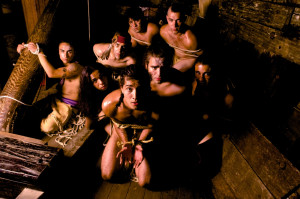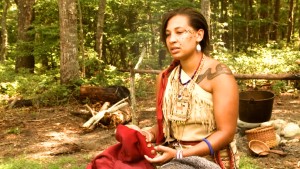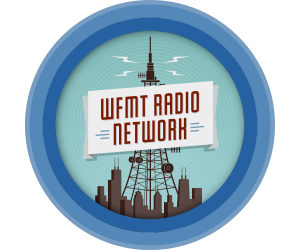Arts Week
Captured 1614
 The Mayflower arrived in what is now known as Provincetown Harbor in (according to the European calendar) November of 1620. But the happy fictional images of the first Thanksgiving were not the first encounter between the Native population and the Europeans, and the exhibition Captured 1614 currently on display at the Pilgrim Monument and Provincetown Museum tells a darker story.
The Mayflower arrived in what is now known as Provincetown Harbor in (according to the European calendar) November of 1620. But the happy fictional images of the first Thanksgiving were not the first encounter between the Native population and the Europeans, and the exhibition Captured 1614 currently on display at the Pilgrim Monument and Provincetown Museum tells a darker story.
In the summer of 1614, Thomas Hunt, arguably acting against specific orders from the absent Captain John Smith, captured and kidnapped 27 Wampanoag men from Patuxet. He sent them to Spain to be sold as slaves.
Let’s back up a moment. The name Wampanoag means People of the First Light. In the 1600s, there were as many as 40,000 people in the 67 villages that made up the Wampanoag Nation, covering a territory stretching from Wessegusset (Weymouth) through the Cape and islands and down into Rhode Island. Their way of life followed the cycle of the seasons: they lived in forests and valleys in winter, and moved closer to rivers and the ocean to plant crops and fish in spring, summer, and fall. A way of life in complete harmony with nature.
 These are the people the European “explorers” encountered in their search for riches. When the anticipated gold did not materialize, many of them, like John Hunt, made up for it in flesh instead. Of the 27 men captured, only one ever came home again.
These are the people the European “explorers” encountered in their search for riches. When the anticipated gold did not materialize, many of them, like John Hunt, made up for it in flesh instead. Of the 27 men captured, only one ever came home again.
The Europeans left good records. History is always written by the winners, and we’ve had centuries of hearing only the European side of these first encounters. But now the nonprofit organization Plymouth 400 is giving voice to the voiceless through Captured 1614—literally. Developed, designed, and produced by Wampanoag people, the exhibition features contemporary Aquinnah Wampanoag and Mashpee Wampanoag speaking the words and portraying the lives of their ancestors.
These men were not statistics: they were people. They were husbands, fathers, sons, brothers, friends. They were loved and needed by their community, and they were ripped from it to satisfy rapacious greed.
We’ve come late to enabling the Wampanoag to tell their side of this story to the wider world, but now, finally, their voices can be heard. Through June 30th, you can hear them at the Pilgrim Monument and Provincetown Museum. Isn’t it time you heard history told—and events remembered—from the other side?












